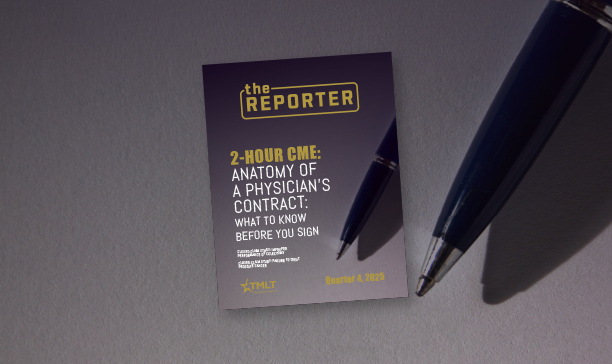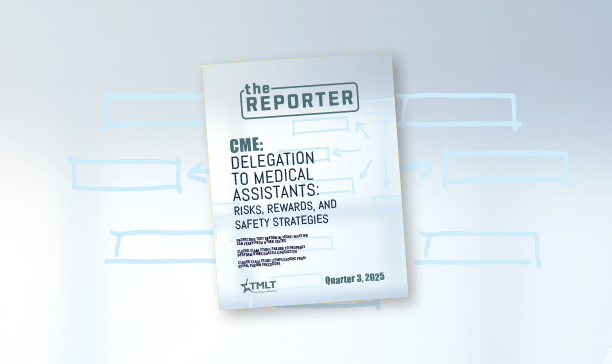Improper performance of colectomy
An 80-year-old woman came to General Surgeon A for a colorectal screening. Three years earlier, the patient had a colonoscopy that showed several polyps; not all of them were removed.
Presentation
An 80-year-old woman came to General Surgeon A for a colorectal screening. She had a history of irritable bowel syndrome with diarrhea. Three years earlier, the patient had a colonoscopy that showed several polyps; not all of them were removed. The patient’s history also included heavy alcohol use and smoking.
Physician action
During an office visit on January 10, General Surgeon A recommended an upper and lower endoscopy based on the patient’s existing polyps, change in stool color with NSAID intake, and heme positive stool. The surgery was scheduled for January 12.
On January 11, a CRNA performed a preoperative exam. He noted the patient’s chest was clear to auscultation and her neurologic system was normal. The patient reported no prior issues with anesthesia.
General Surgeon A performed an esophagogastroduodenoscopy, colonoscopy with biopsies, and a polypectomy using cold biopsy forceps on January 12. The postoperative report documented findings of a tumor in the cecum, rectal polyp, polyps of the right colon, and normal upper gastrointestinal endoscopy. The pathology report indicated a cecum mass “invasive moderately differentiated adenocarcinoma, microsatellite, unstable tumor; rectal polyp biopsy — hyperplastic polyp fragments.”
Upon learning that the biopsied specimen was positive for colorectal cancer, the patient wanted to remain in the hospital overnight and proceed with a partial colectomy on January 13. General Surgeon A notified the patient’s primary care physician (PCP), who saw the patient the evening of January 12. The PCP also saw the patient on January 13 and noted a normal review of systems and plan for surgery that day. The patient’s blood pressure was elevated, thought to be related to anxiety.
The CRNA performed a second anesthesia evaluation on January 13. He changed her ASA score from 3 to 4 and planned for general anesthesia.
General Surgeon A started the laparoscopy at 10:24 a.m. Once the ports were placed and the patient was repositioned (“left tilt, along with some Trendelenburg”), she developed severe hypoxemia, bradycardia, and hypotension. The patient still had a pulse. General Surgeon A stopped the procedure at 10:40 a.m. He removed the ports, began stapling the skin, and placed a right subclavian central line. Resuscitation was carried out and the patient slowly recovered. She was transferred to the ICU intubated and sedated.
The patient’s PCP ordered a cardiology consult, who documented that the patient’s condition was “suggestive of Takotsubo cardiomyopathy.” “However, severe multi-vessel ischemic cardiomyopathy is not excluded. Patient has been under stress since recent colon mass diagnosis.”
That afternoon, the patient was transferred to a medical center under the care of a cardiologist. She developed a possible brain injury with left-sided weakness following the cardiopulmonary instability that occurred intraoperatively; her condition improved and she was discharged one week later.
The patient returned to General Surgeon A in March and wanted to proceed with the colectomy. General Surgeon A recommended that she have the colectomy at the medical center where she could receive a higher level of anesthesia care. General Surgeon B performed the colectomy without complication on April 28.
Allegations
A lawsuit was filed against General Surgeon A, the CRNA, and the hospital. Regarding the actions of General Surgeon A, it was alleged that he should not have attempted the colectomy the day after the patient’s colonoscopy because she was “fluid deficient.” It was further alleged that this action led to the patient’s hypoxic brain injury and subsequent lasting mental and physical disabilities.
Legal implications
General Surgeon A’s actions in this case were supported by defense experts and the patient’s subsequent treating physicians. The patient had an adenocarcinoma of the cecum and resection was indicated. Once the pathology results were received and the colectomy discussed, General Surgeon A required additional testing and work up to ensure it was safe to perform the surgery on January 13.
The patient’s PCP — who had treated the patient for 20 years and was aware of her comorbidities — supported the timing of the procedure. She cleared the patient for surgery based on the results of her echocardiogram and stress test.
During the colectomy, General Surgeon A responded appropriately when the severe hypotension occurred by returning the patient to a neutral position and initiating resuscitation. The cardiologist’s work-up of the patient upon being admitted to the ICU suggested that the incident was the result of a myocardial infarction and coronary artery disease.
The plaintiff’s general surgery expert developed an alternative argument. He testified that the colectomy was non-emergent and should have been delayed to allow the patient to “rehydrate” from the colonoscopy before she prepped for the colectomy.
This allegation was based on documentation that the patient was negative 550 mls on January 12 and negative 1100 mls on January 13. Further, this expert stated that there was no indication that the patient was receiving fluids to balance the bowel prep. However, he did concede that the patient’s output of 1300 mls meant that she was hydrated.
Regarding the allegations against the CRNA and hospital, the plaintiff’s anesthesiology expert stated that the CRNA should not have been allowed to evaluate the patient independently, without any delegation or supervision from a physician. The expert stated that doing so was a breach in the standard of care, as physician supervision was required by Texas Medical Board regulations.
However, the surgeries took place at a rural, community hospital, which are often vulnerable to a lack of providers and resources. At the time of these surgeries, an on-site anesthesiologist was not available, leaving General Surgeon A to delegate anesthesia selection and administration to the CRNA. It was then argued that General Surgeon A did not properly oversee the CRNA’s work.
On January 13, the CRNA did change the patient’s ASA score from 3 to 4, indicating she was at high risk for complications that pose a threat to life. Therefore, it was also stated that the patient should not have been cleared for surgery because she was high risk and severely dehydrated.
Disposition
This case was taken to trial, and the jury reached a verdict in favor of the plaintiffs.
Risk management considerations
This case highlights the importance of careful preoperative assessment, communication, and adherence to delegation and supervision requirements — particularly in high-risk surgical patients and resource-limited hospital settings. Although the care provided by General Surgeon A was supported by defense experts, the case was lost at trial. This outcome underscores how medical decisions can be vulnerable to juror perceptions when documentation is limited.
One of the central issues in this case was the timing of surgery. The patient underwent a colonoscopy and bowel prep on January 12, followed by a partial colectomy scheduled for January 13. While the decision to proceed was medically supported and the patient was cleared by her PCP, the plaintiff’s experts argued that the patient was fluid deficient from the bowel prep and colonoscopy. They claimed the patient’s negative fluid balance contributed to intraoperative instability and subsequent brain injury. Documentation of hydration status and fluid replacement was limited, which made it difficult to refute this claim.
A clear note documenting the rationale for proceeding — along with evidence of preoperative fluid and electrolyte evaluation — may have been pivotal in defending the timing of surgery. This documentation is especially important for patients with comorbidities that increase perioperative risk.
An additional area of scrutiny was the anesthesia delegation, supervision and oversight process. The CRNA performed both preoperative evaluations without a supervising anesthesiologist present. While this arrangement may be common in rural hospitals, hospitals with limited staffing should establish written protocols defining supervision responsibilities, documentation requirements, and procedures for escalating care to other facilities.
Communication among the care team also played a significant role. General Surgeon A, the PCP, and the CRNA each examined the patient, but the records lacked a clear indication of the patient’s risk factors, hydration status, and evolving ASA classification. When multiple providers treat a patient, it is essential that all members of the team document consistent findings and communicate any changes that could affect surgical readiness.
Finally, this case illustrates how a medically reasonable course of action can be difficult to defend if documentation leaves room for interpretation. Taking steps to clearly and fully document such details as patient condition, delegation, and physician reasoning can strengthen the defensibility of care should an adverse outcome occur.
Disclaimer
Presentation
An 80-year-old woman came to General Surgeon A for a colorectal screening. She had a history of irritable bowel syndrome with diarrhea. Three years earlier, the patient had a colonoscopy that showed several polyps; not all of them were removed. The patient’s history also included heavy alcohol use and smoking.
Physician action
During an office visit on January 10, General Surgeon A recommended an upper and lower endoscopy based on the patient’s existing polyps, change in stool color with NSAID intake, and heme positive stool. The surgery was scheduled for January 12.
On January 11, a CRNA performed a preoperative exam. He noted the patient’s chest was clear to auscultation and her neurologic system was normal. The patient reported no prior issues with anesthesia.
General Surgeon A performed an esophagogastroduodenoscopy, colonoscopy with biopsies, and a polypectomy using cold biopsy forceps on January 12. The postoperative report documented findings of a tumor in the cecum, rectal polyp, polyps of the right colon, and normal upper gastrointestinal endoscopy. The pathology report indicated a cecum mass “invasive moderately differentiated adenocarcinoma, microsatellite, unstable tumor; rectal polyp biopsy — hyperplastic polyp fragments.”
Upon learning that the biopsied specimen was positive for colorectal cancer, the patient wanted to remain in the hospital overnight and proceed with a partial colectomy on January 13. General Surgeon A notified the patient’s primary care physician (PCP), who saw the patient the evening of January 12. The PCP also saw the patient on January 13 and noted a normal review of systems and plan for surgery that day. The patient’s blood pressure was elevated, thought to be related to anxiety.
The CRNA performed a second anesthesia evaluation on January 13. He changed her ASA score from 3 to 4 and planned for general anesthesia.
General Surgeon A started the laparoscopy at 10:24 a.m. Once the ports were placed and the patient was repositioned (“left tilt, along with some Trendelenburg”), she developed severe hypoxemia, bradycardia, and hypotension. The patient still had a pulse. General Surgeon A stopped the procedure at 10:40 a.m. He removed the ports, began stapling the skin, and placed a right subclavian central line. Resuscitation was carried out and the patient slowly recovered. She was transferred to the ICU intubated and sedated.
The patient’s PCP ordered a cardiology consult, who documented that the patient’s condition was “suggestive of Takotsubo cardiomyopathy.” “However, severe multi-vessel ischemic cardiomyopathy is not excluded. Patient has been under stress since recent colon mass diagnosis.”
That afternoon, the patient was transferred to a medical center under the care of a cardiologist. She developed a possible brain injury with left-sided weakness following the cardiopulmonary instability that occurred intraoperatively; her condition improved and she was discharged one week later.
The patient returned to General Surgeon A in March and wanted to proceed with the colectomy. General Surgeon A recommended that she have the colectomy at the medical center where she could receive a higher level of anesthesia care. General Surgeon B performed the colectomy without complication on April 28.
Allegations
A lawsuit was filed against General Surgeon A, the CRNA, and the hospital. Regarding the actions of General Surgeon A, it was alleged that he should not have attempted the colectomy the day after the patient’s colonoscopy because she was “fluid deficient.” It was further alleged that this action led to the patient’s hypoxic brain injury and subsequent lasting mental and physical disabilities.
Legal implications
General Surgeon A’s actions in this case were supported by defense experts and the patient’s subsequent treating physicians. The patient had an adenocarcinoma of the cecum and resection was indicated. Once the pathology results were received and the colectomy discussed, General Surgeon A required additional testing and work up to ensure it was safe to perform the surgery on January 13.
The patient’s PCP — who had treated the patient for 20 years and was aware of her comorbidities — supported the timing of the procedure. She cleared the patient for surgery based on the results of her echocardiogram and stress test.
During the colectomy, General Surgeon A responded appropriately when the severe hypotension occurred by returning the patient to a neutral position and initiating resuscitation. The cardiologist’s work-up of the patient upon being admitted to the ICU suggested that the incident was the result of a myocardial infarction and coronary artery disease.
The plaintiff’s general surgery expert developed an alternative argument. He testified that the colectomy was non-emergent and should have been delayed to allow the patient to “rehydrate” from the colonoscopy before she prepped for the colectomy.
This allegation was based on documentation that the patient was negative 550 mls on January 12 and negative 1100 mls on January 13. Further, this expert stated that there was no indication that the patient was receiving fluids to balance the bowel prep. However, he did concede that the patient’s output of 1300 mls meant that she was hydrated.
Regarding the allegations against the CRNA and hospital, the plaintiff’s anesthesiology expert stated that the CRNA should not have been allowed to evaluate the patient independently, without any delegation or supervision from a physician. The expert stated that doing so was a breach in the standard of care, as physician supervision was required by Texas Medical Board regulations.
However, the surgeries took place at a rural, community hospital, which are often vulnerable to a lack of providers and resources. At the time of these surgeries, an on-site anesthesiologist was not available, leaving General Surgeon A to delegate anesthesia selection and administration to the CRNA. It was then argued that General Surgeon A did not properly oversee the CRNA’s work.
On January 13, the CRNA did change the patient’s ASA score from 3 to 4, indicating she was at high risk for complications that pose a threat to life. Therefore, it was also stated that the patient should not have been cleared for surgery because she was high risk and severely dehydrated.
Disposition
This case was taken to trial, and the jury reached a verdict in favor of the plaintiffs.
Risk management considerations
This case highlights the importance of careful preoperative assessment, communication, and adherence to delegation and supervision requirements — particularly in high-risk surgical patients and resource-limited hospital settings. Although the care provided by General Surgeon A was supported by defense experts, the case was lost at trial. This outcome underscores how medical decisions can be vulnerable to juror perceptions when documentation is limited.
One of the central issues in this case was the timing of surgery. The patient underwent a colonoscopy and bowel prep on January 12, followed by a partial colectomy scheduled for January 13. While the decision to proceed was medically supported and the patient was cleared by her PCP, the plaintiff’s experts argued that the patient was fluid deficient from the bowel prep and colonoscopy. They claimed the patient’s negative fluid balance contributed to intraoperative instability and subsequent brain injury. Documentation of hydration status and fluid replacement was limited, which made it difficult to refute this claim.
A clear note documenting the rationale for proceeding — along with evidence of preoperative fluid and electrolyte evaluation — may have been pivotal in defending the timing of surgery. This documentation is especially important for patients with comorbidities that increase perioperative risk.
An additional area of scrutiny was the anesthesia delegation, supervision and oversight process. The CRNA performed both preoperative evaluations without a supervising anesthesiologist present. While this arrangement may be common in rural hospitals, hospitals with limited staffing should establish written protocols defining supervision responsibilities, documentation requirements, and procedures for escalating care to other facilities.
Communication among the care team also played a significant role. General Surgeon A, the PCP, and the CRNA each examined the patient, but the records lacked a clear indication of the patient’s risk factors, hydration status, and evolving ASA classification. When multiple providers treat a patient, it is essential that all members of the team document consistent findings and communicate any changes that could affect surgical readiness.
Finally, this case illustrates how a medically reasonable course of action can be difficult to defend if documentation leaves room for interpretation. Taking steps to clearly and fully document such details as patient condition, delegation, and physician reasoning can strengthen the defensibility of care should an adverse outcome occur.
Disclaimer
Want to save this article for later?
Download the full article as a PDF for future reference or to share with colleagues.
Subscribe to Case Closed to receive insights from resolved cases.
You’ll receive two closed claim studies every month. These closed claim studies are provided to help physicians improve patient safety and reduce potential liability risks that may arise when treating patients.
Related Resources
Discover more insights, stories, and resources to keep you informed and inspired.





